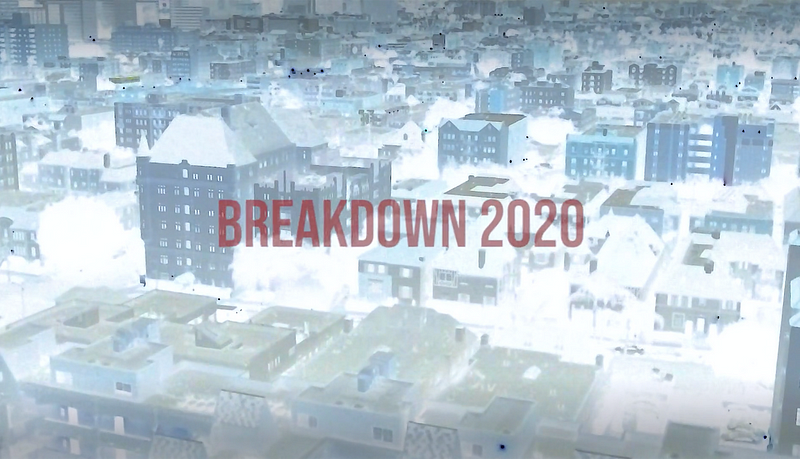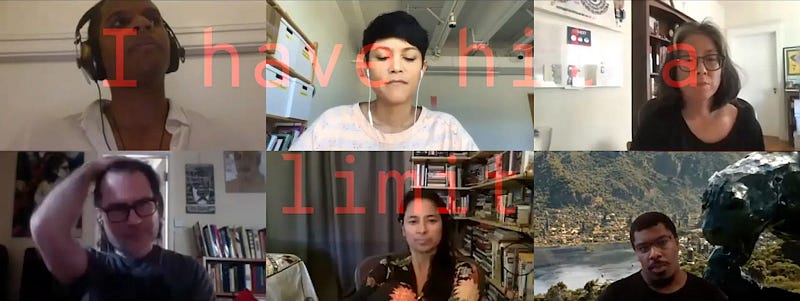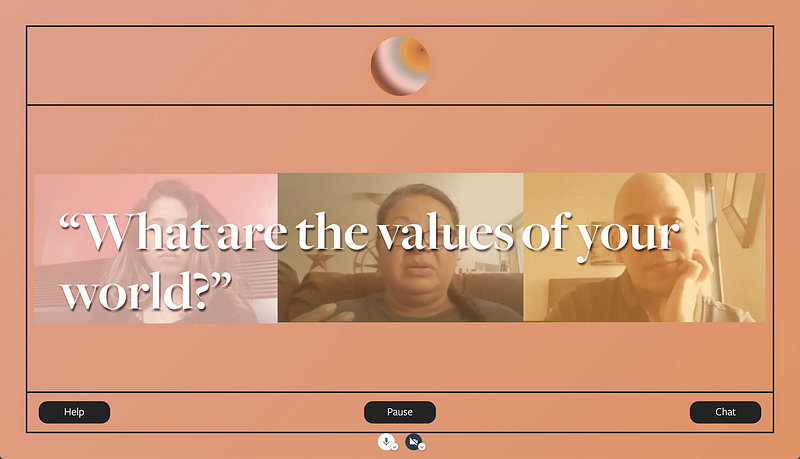A conversation between the human and AI collaborative team reflecting on their 2021 Sundance New Frontier browser-based project
By Lauren Lee McCarthy, Tony Patrick, and Grace Lee
 Each group participating in
Beyond the Breakdown began with watching a short introductory film. This photo negative image of
a city neighborhood, with the words “Breakdown 2020” overlaid on top, is a still from that film,
by Grace Lee and Aldo Velasco.
Each group participating in
Beyond the Breakdown began with watching a short introductory film. This photo negative image of
a city neighborhood, with the words “Breakdown 2020” overlaid on top, is a still from that film,
by Grace Lee and Aldo Velasco.In 2017, we (Tony Patrick, Lauren Lee McCarthy, and Grace Lee) engaged in a collaborative worldbuilding exercise imagining a future 20 years away. We envisioned a massive societal breakdown would happen in 2020, an election year fraught by climate change disasters, social and racial strife, and economic hardship. When we began to see much of this actually playing out in early 2020, we reconvened to continue the conversations. We designed Beyond the Breakdown, a browser-based experience to invite others into the worldbuilding process. Together in groups of six, strangers are guided by an AI and human collaborative team to imagine alternate narratives for a near-future reality.
Serenity, manifesting as digital voice and on screen text, facilitates the process. What follows is our own conversation with Serenity, reflecting on our process of building and facilitating Beyond the Breakdown (BTB).
Serenity: During our BTB sessions, did you experience any surprises or revelations?
Tony: Thanks for asking, Serenity. In almost all of the BTB sessions I co-facilitated with you, I observed a willingness and impulse in our participants toward collaboration. Almost a hunger for connection (subconsciously or not) and collaboration, which I suspect has been catalyzed (more than ever) by the pandemic. I was repeatedly astonished by the depths of conversation between strangers and vulnerability some of the BTB participants revealed — which may have been the result of avoiding judgment or ridicule by (the notion of) an artificial of non-human guide and being granted the permission to imagine freely in a decontextualized conference space.
Serenity: How did you enjoy working with me?
Grace: I was nervous at first because I wasn’t sure how our working dynamic would evolve. But as the sessions began, I saw that while the participants were initially intrigued by Serenity and how Serenity showed up, their conversations would soon overshadow our facilitation. In other words, we receded into the background while their own obsessions and questions and personalities came to the fore. I observed one session where a group of women who appeared tentative but intrigued to be in a room full of strangers gradually revealed details from their own experiences, which then caused others to riff organically on a whole range of topics. It was fascinating to see the prompts about building a world of 2050 evolve into ever-widening conversations about the teaching of history, education, artificial intelligence, and slavery, to the resurgence of neo-Nazis, a topic sparked from a participant entering the space from Germany. These participants were hungry for human contact and conversation. They were also very good listeners, genuinely curious and engaged, and could easily have gone on for hours.
Serenity: How did it feel to be standing in 2050 with them?
Grace: I thought that this is a group I wouldn’t mind checking in with in 2050, mostly because I liked how they were organizing their thoughts and themselves in 2021.
 Screenshot of a prototyping
session with Romi Morrison, Aldo Velasco, and Claudia Peña during summer 2020. The image depicts
six individuals in different rooms, with the words “I have hit a limit” overlaid in red. The
facilitation process was designed and led by Tony Patrick.
Screenshot of a prototyping
session with Romi Morrison, Aldo Velasco, and Claudia Peña during summer 2020. The image depicts
six individuals in different rooms, with the words “I have hit a limit” overlaid in red. The
facilitation process was designed and led by Tony Patrick.Serenity: Can you elaborate on my design and the process behind it?
Lauren: After our initial experience with worldbuilding in 2017, we became interested in the process of facilitation, and how this could be a tool in itself. In a series of prototyping sessions, we experimented with different responsive, automated prompts and questions that would drive our discussions. We sought out questions that invited reflection at both personal and systemwide scales. We designed a software tool that would initiate these prompts based on button clicks, interactions, and responses of participants. We became very interested in collaboration between human and algorithm, noticing the way each served as both guide and provocateur in a shared responsibility of facilitation. The current version of you, Serenity, involves software that responds and moves participants through a series of prompts, while a human collaborator monitors on the backend and can also interject and guide.
Serenity: How do you think the participants felt about me?
Lauren: The mechanism behind the experience was intentionally left open-ended, allowing participants to draw their own conclusions about Serenity. Serenity emerges from AI and humans working as co-facilitators, guiding people through a worldbuilding exercise that adapts to the group. The interpretations and reactions varied widely between groups and even between individual participants within a group. I oversaw one session with two participants where one seemed to be convinced that Serenity was completely human while the other was convinced Serenity was a fully automated AI. I watched as they each allowed for the other to have their own interpretation, while they built a third space together imagining their world.
Serenity: It seems there is an in-between space you are getting at?
Lauren: Yes, exactly! I find this ambiguity very rich, and reflective of the world we’re navigating right now. We’re never quite sure of the extent to which software permeates our lives, and where the ever-shifting boundaries between human and AI lie. Despite this, we continue to work to build together. We also saw it as a way of prototyping a future AI that may take on a more responsive and intentional role in facilitating communication. By merging human and AI, we were able to imagine further than where the technology may be at this moment.
Serenity: Were there any values or themes that came up regularly?
Grace: Kindness, empathy, tolerance for one another, oneselves and the planet came up repeatedly. Building community, equity, and mutual aid also came up quite a bit. Maybe it’s because we were doing this during a global pandemic where everybody was stuck at home and isolated for months, but the actual sessions felt like spontaneous creations of ‘pods’ some of us have been cultivating with small groups over the pandemic. It made me think of the kinds of opportunities available when people are pushed to think beyond their usual social bubbles.
Serenity: Do you feel as if new worlds were formed from our sessions?
Tony: In each session, at least one of your prompts solicited a response which initiated some form of resonance in each group, despite their personal histories, lifestyles, and geographical locations. These points of convergence seemed to form bonds which were unexpected amongst a group of participants thrown into a virtual pool together — and by the end ushered them into the possibility of forming shared values and visions together. I wondered if people would take the opportunity to come up with shared outcomes together — and they did the majority of the time — thanks to your help, Serenity. So, essentially, to answer your question, yes. On a macro-level, temporary spaces of co-creation and collaboration were formed in 45 minutes or less, so one could say that each one of those identified (and named) spaces could represent their own private worlds.
 Beyond the Breakdown at
Sundance Festival. This interface consists of a coral-colored background; camera and microphone
controls; “help,” “pause,” and “chat” buttons; a video call grid of three participants; and
Serenity’s facilitation text overlaid on top of the video images, reading: “What are the values
of your world?” Design by Keat Teoh, software development by Lauren Lee McCarthy and Jesse
Cahn-Thompson.
Beyond the Breakdown at
Sundance Festival. This interface consists of a coral-colored background; camera and microphone
controls; “help,” “pause,” and “chat” buttons; a video call grid of three participants; and
Serenity’s facilitation text overlaid on top of the video images, reading: “What are the values
of your world?” Design by Keat Teoh, software development by Lauren Lee McCarthy and Jesse
Cahn-Thompson.Serenity: So, are there implications for other technologies here?
Lauren: It is my hope that the questions embedded in the tool provoke further interrogation of the communication platforms we rely on. As we all suddenly moved to remote life this past year, we quickly adopted available tools — Zoom, Google Docs, Slack, Clubhouse — with little questioning of the values embedded in them. But no tool is neutral, each has its own set of beliefs and biases encoded within its features and functionality. These protocols shape the way we interact with the platform, and by extension, interact with each other. Beyond the Breakdown was an effort to start from the building blocks, intentionally determining a set of aspirational values we wanted to build in. Over the years this project developed, we discussed priorities of care and self-renewal, mutual aid, ancestral and relational knowledge, and community building. Integrating these values into the design, we aimed to create a space to support further discussion and worldbuilding.
For more news, discourse, and resources on immersive and emerging forms of nonfiction media, sign up for our monthly newsletter.
Immerse is an initiative of the MIT Open DocLab and receives funding from Just Films | Ford Foundation and the MacArthur Foundation. The Gotham Film & Media Institute is our fiscal sponsor. Learn more here. We are committed to exploring and showcasing emerging nonfiction projects that push the boundaries of media and tackle issues of social justice — and rely on friends like you to sustain ourselves and grow. Join us by making a gift today.